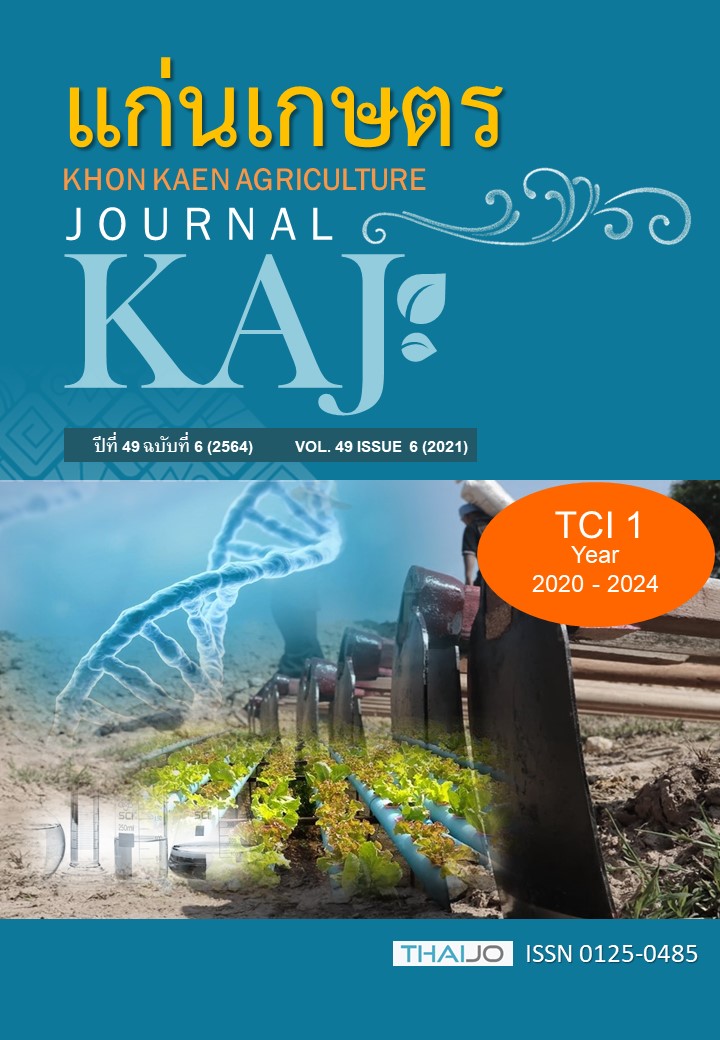ผลของมูลโคและมูลสุกรต่อการเจริญเติบโต และผลผลิตของแหนแดง (Azolla microphylla)
Main Article Content
บทคัดย่อ
งานวิจัยนี้มีวัตถุประสงค์เพื่อศึกษาอัตราส่วนของการใช้มูลโคและมูลสุกรที่เหมาะสมต่อการเจริญเติบโต และปริมาณธาตุอาหารในแหนแดง เพื่อเป็นแนวทางให้กับเกษตรกรสำหรับการเพาะเลี้ยงแหนแดงต่อไป วางแผนการทดลองแบบ Completely Randomized Design (CRD) ประกอบด้วย 6 สิ่งทดลอง จำนวน 3 ซ้ำ ได้แก่ T1: ไม่ใส่มูลสัตว์ (ควบคุม) T2: ใส่มูลโคเพียงอย่างเดียว T3: ใส่มูลสุกรเพียงอย่างเดียว และ T4-T6: ใส่มูลโคร่วมกับมูลสุกรอัตราส่วน 25:75, 50:50 และ 75:25 โดยน้ำหนัก ตามลำดับ เพาะเลี้ยงแหนแดงในบ่อซีเมนต์เป็นระยะเวลา 30 วัน จากผลการทดลองพบว่า การใส่มูลโคร่วมกับมูลสุกรในทุกอัตราส่วนทำให้แหนแดงมีน้ำหนักสดรวมมากที่สุดอย่างมีนัยสำคัญ ซึ่งมีค่าอยู่ในช่วง 1,890.07-1,824.60 กรัมต่อตารางเมตร ทั้งนี้แม้ว่าการให้ปุ๋ยมูลสัตว์ทุกชนิดทำให้น้ำหนักแห้งสุทธิรวมมีค่ามากกว่าการไม่ให้ปุ๋ยอย่างมีนัยสำคัญ แต่ไม่พบความแตกต่างระหว่างการให้ปุ๋ยมูลสัตว์ที่แตกต่างกัน โดยทำให้แหนแดงมีน้ำหนักแห้งสุทธิรวมอยู่ในช่วง 21.49-22.20 กรัม ซึ่งสอดคล้องกับปริมาณธาตุอาหารหลัก (N+P+K) ที่พบว่า การให้ปุ๋ยทุกชนิดทำให้ปริมาณธาตุอาหารหลักรวมมีค่าไม่แตกต่างกัน (1.46-1.74 กรัมต่อกรัมน้ำหนักแห้ง) อย่างไรก็ตามเป็นที่น่าสังเกตว่า การให้ปุ๋ยมูลสุกรเพียงอย่างเดียวทำให้แหนแดงมีการสะสมของไนโตรเจนและฟอสฟอรัสทั้งหมดมากที่สุด คือ 3.97 และ 0.56 เปอร์เซ็นต์ ตามลำดับ ในขณะที่การให้ปุ๋ยมูลโคเพียงอย่างเดียวหรือปุ๋ยมูลโคร่วมกับมูลสุกรอัตราส่วน 50:50 โดยน้ำหนัก ทำให้แหนแดงมีการสะสมของปริมาณโพแทสเซียมทั้งหมดมากที่สุด คือ 4.58 และ 4.29 เปอร์เซ็นต์ ตามลำดับ
Article Details

อนุญาตภายใต้เงื่อนไข Creative Commons Attribution-NonCommercial-NoDerivatives 4.0 International License.
เอกสารอ้างอิง
กรมพัฒนาที่ดิน. 2553. คู่มือการปฏิบัติงานกระบวนการวิเคราะห์พืช ปุ๋ย และสิ่งปรับปรุงดิน. กระทรวงเกษตรและสหกรณ์, กรุงเทพฯ.
เทวรัตน์ ตรีอำนรรค. 2557. การศึกษาแนวทางการผลิตปุ๋ยอินทรีย์อย่างครบวงจร. รายงานการวิจัยฉบับสมบูรณ์ สาขาวิชาวิศวกรรมเกษตรและอาหาร สำนักวิชาวิทยาศาสตร์ มหาวิทยาลัยเทคโนโลยีสุรนารี, นครราชสีมา.
ปริศนา อัครพงษ์สวัสดิ์. 2560. ประสิทธิภาพจุลินทรีย์อีเอ็มร่วมกับมูลสัตว์ต่อผลผลิตแหนแดง. วารสารวิจัยและนวัตกรรมการอาชีวศึกษา. 1(1): 86-93.
พีรยุทธ สิริฐนกร, อารยา อาจเจริญ เทียนหอม, ศิริลักษณ์ แก้วสุรลิขิต, กัลยาณี สุวิทวัส, พิมพ์นิภา เพ็งช่าง, เจนจิรา ชุมภูคำ และทัศไนย จารุวัฒนพันธ์. 2559. ผลของไมคอร์ไรซาร่วมกับผลิตภัณฑ์ปุ๋ยชีวภาพต่อการอยู่รอดและการเจริญเติบโตของต้นกล้ากล้วยน้ำว้าพันธุ์ปากช่อง 50 ในแปลงปลูก. วารสารวิทยาศาสตร์เกษตร. 2(พิเศษ): 357-360.
ยงยุทธ โอสถสภา, อรรถศิษฐ์ วงศ์มณีโรจน์ และชวลิต ฮงประยูร. 2554. ปุ๋ยเพื่อการเกษตรยั่งยืน. พิมพ์ครั้งที่ 2, สำนักพิมพ์มหาวิทยาลัยเกษตรศาสตร์, กรุงเทพฯ.
ศิราภรณ์ ชื่นบาล, วิภาพร จารุธนกุล, ฐปน ชื่นบาล และปานวาด ศิลปวัฒนา. 2560. การศึกษาการเจริญและการสลายตัวของแหนแดง, น. 132-138. ใน: รายงานการประชุมวิชาการของมหาวิทยาลัยแม่โจ้ 7-8 ธันวาคม 2560. มหาวิทยาลัยแม่โจ้, เชียงใหม่.
ศิราภรณ์ ชื่นบาล และฐปน ชื่นบาล. 2562. การศึกษาการเจริญ การสะสม และการปลดปล่อยธาตุอาหารของแหนแดงที่เลี้ยงด้วยน้ำทิ้งจากฟาร์มเลี้ยงสุกร. RMUTI JOURNAL Science and Technology. 12(1): 86-96.
ศิริลักษณ์ แก้วสุรลิขิต และประไพ ทองระอา. 2557. การศึกษาสัดส่วนที่เหมาะสมของแหนแดงที่ใช้เป็นวัสดุพาสำหรับการผลิตปุ๋ยชีวภาพละลายฟอสเฟต. กลุ่มวิจัยปฐพีวิทยา, สำนักวิจัยพัฒนาปัจจัยการผลิตทางการเกษตร, กรมวิชาการเกษตร, กรุงเทพฯ.
Aziz, T., and I. Watanabe. 1983. Influence of nutrients on the growth and mineral composition of Azolla pinnata. Bangladesh Journal of Botany. 12(2): 166-170.
Biswas, M., S. Parveen, H. Shimozawa, and N. Nakagoshi. 2005. Effects of Azolla species on weed emergence in a rice paddy ecosystem. Weed Biology Management. 5: 176-183.
Cary, P.R., and P.G.J. Weerts. 1992. Growth and nutrient composition of A. pinnata R. Brown and A. filiculoides Lamarck as affected by water temperature, nitrogen and phosphorus supply, light intensity and pH. Aquatic Botany. 43: 163-180.
Costa, M.L., M.C.R. Santos, F. Carrapico, and A.L. Pereira. 2009. Azolla-Anabaena’s behaviour in urban wastewater and artificial media: Influence of combined nitrogen. Water Research. 43(15): 3743-3750.
EL Katony, T.M., M.S. Serao, A.M. Badway, and M.A. Mousa. 1996. Effect of phosphorus on growth and uptake of nutrients by A. filiculoides Lam. Journal of Environmental Sciences. 12: 69-88.
Forni, C., F. Giordani, M. Pintore, and L. Campanella. 2008. Effects of sodium dodecyl sulphate on the aquatic macrophytes Azolla and Lemna. Plant Biosystems. 142(3): 665-668.
Handajani, H. 2011. Optimation of nitrogen and phosphorus in azolla growth as biofertilizer. Makara Journal of Technology. 15(2): 142-146.
Hunt, R. 1990. Basic growth analysis: Plant growth analysis for beginner. Unwin Hayman Ltd., London.
Indira, D., K.S. Reddy, J. Suresh, V.K. Naidu, and A. Ravi. 2014. Optimum conditions for culturing of Azolla (Azolla pinnata). International Journal of Advanced Research in Biological Sciences 1(2): 87-89.
Reddy, G. R. 1991. Studies on the growth of azolla in relation to potassium, calcium, magnesium and sulphur nutrition. M.Sc. Thesis, Andhra Pradesh Agricultural University, Hyderabad.
Sadeghi, R., R. Zarkami, K. Sabetraftar, and P.V. Damme. 2013. A review of some ecological factors affecting the growth of Azolla spp. Caspian Journal of Environmental Sciences. 11(1): 65-76.
Subudhi, B.P.R., and P.K. Singh. 1979. Effect of phosphorus and nitrogen on growth, chlorophyll, amino nitrogen, soluble sugar contents and algal heterocysts of water fern Azolla pinnata. Biologia Plantarum. 21: 401-406.
TejaswinI, G.S., S. Mahadevakumar, and G.R. janardhana. 2015. Effect of Azolla pinnata on seed germination, vigour index, biomass and yield of French bean (Phaseolus vulgaris). Current Agriculture Research Journal. 3(2): 137-141.
Tuan, D.T., and T.Q. Thuyet. 1979. Use of azolla in rice production in Vietnam. P. 395-405. In: Nitrogen and Rice. International Rice Research Institute, Los Banos, Philippines.
Utomo, R., C.T. Noviandi, N. Umami, and A. Permadi. 2019. Effect of composted animal manure as fertilizer on productivity of Azolla pinnata grown in Earthen ponds. Online Journal of Biological Sciences. 19(4): 232-236.
Walkley, A., and I.A. Black. 1934. An examination of Degtjareff method for determining soil organic matter and a proposed modification of the chromic acid titration method. Soil Science. 37: 29-37.
Wu, S.M., and C.A. Rebeiz. 1985. Chloroplast biogenesis: Molecular structure of chlorophyll b (E489 F666). The Journal of Biological Chemistry. 260: 3632-3664.


